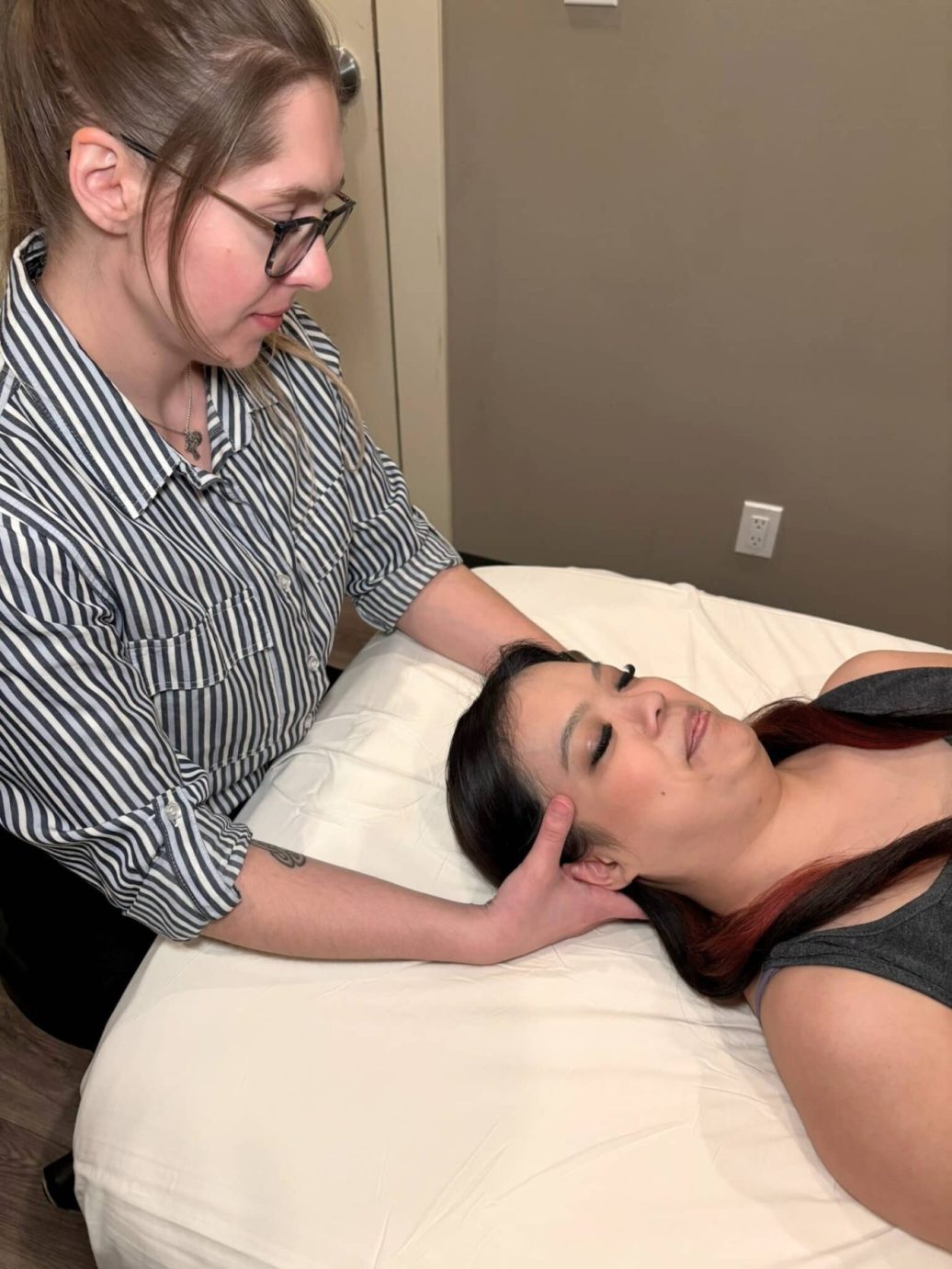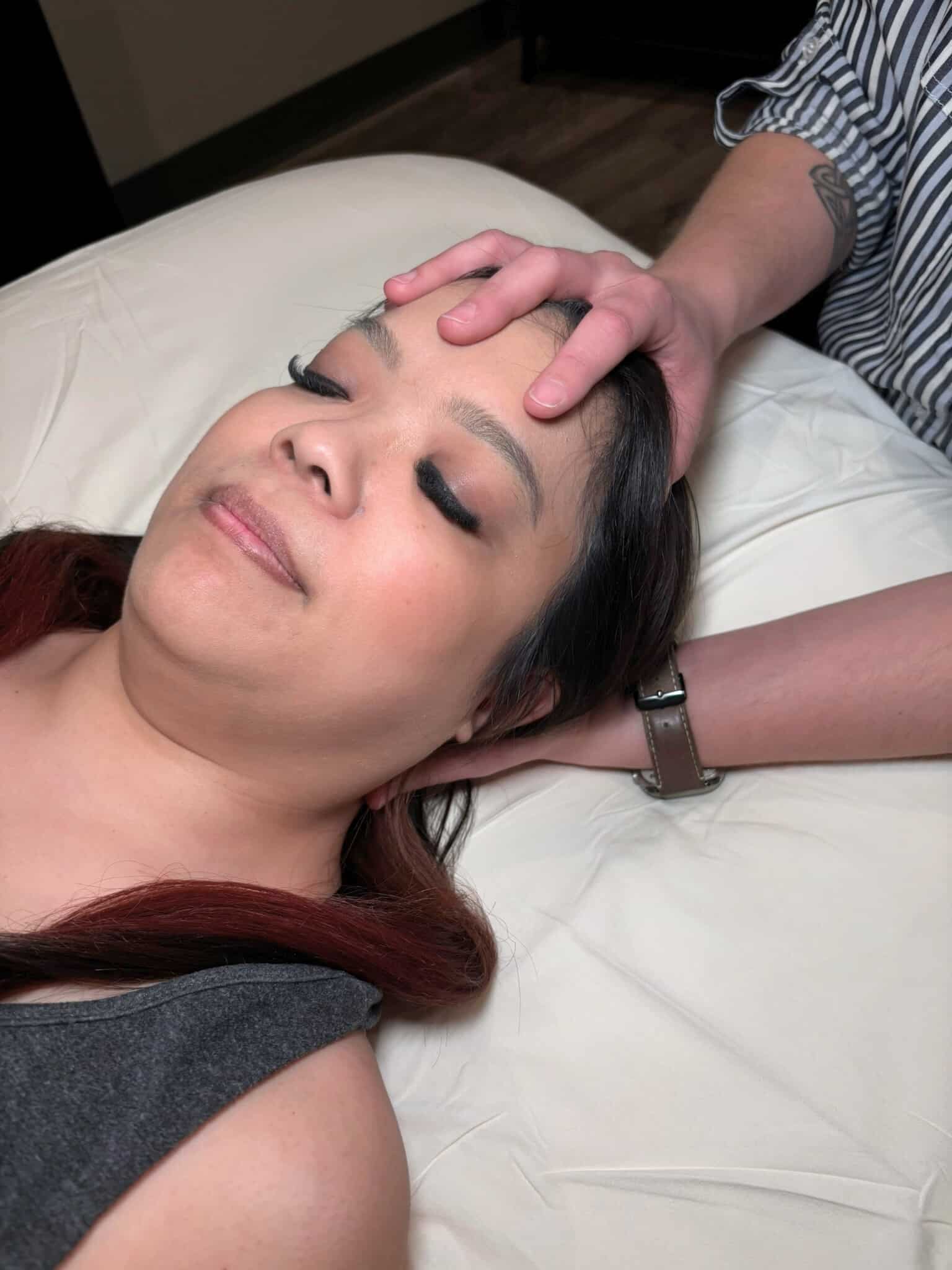
Have you ever felt a whisper of tension clinging to the base of your skull, a persistent throb behind your eyes, or a deep ache that no amount of stretching seems to soothe? Craniosacral massage is a gentle, non-invasive therapy that targets the craniosacral system—the membranes and fluids surrounding the brain and spinal cord—to release tension, reduce pain, and support the central nervous system. It is commonly used to promote deep relaxation, relieve chronic pain, and improve overall health. As you settle onto the massage table, the soothing environment envelops you, inviting you to shed the weight of your worries.
What is Craniosacral Therapy?
Craniosacral therapy focuses on the body’s connective tissue, primarily the fascia surrounding organs, muscles, and the nervous system. Craniosacral therapists use soft tissue manipulation techniques to release restrictions and restore balance throughout the body. South West Massage & Wellness explains, “Craniosacral Therapy (CST) is a gentle, hands-on technique that helps release tension and optimize the movement of cerebrospinal fluid (CSF), which surrounds and cushions the brain and spinal cord. Practitioners use light touch to assess and enhance the body’s natural cerebrospinal rhythm, helping to restore balance in the nervous system.”
- Gentle Touch: Therapists apply minimal pressure to facilitate relaxation.
- Holistic Approach: CST addresses both physical and emotional symptoms.
- Self-Healing: The body has an innate ability to heal, and CST supports this process.
Research indicates that craniosacral therapy helps relieve various ailments, including headaches, neck pain, and stress-related disorders.
How Craniosacral Massage Works
Craniosacral massage, also known as craniosacral therapy (CST), employs gentle pressure and light touch to facilitate healing within the craniosacral system.. During a craniosacral therapy session, the massage therapist uses light touch techniques to identify and release fascial restrictions in the connective tissues encasing the cranial bones and spinal column. This process helps alleviate tension and improve blood circulation, providing pain relief for conditions such as chronic pain, migraines, and neck pain. By facilitating the movement of CSF and restoring the normal cranial rhythmic impulse, practitioners enable the body to achieve self-correction and greater overall well-being.
Additionally, craniosacral therapy promotes a balance within the autonomic nervous system, guiding it from a stress-dominant state to a parasympathetic state conducive to healing. By improving mobility in key areas like the sacrum and occiput, CST fosters better fluid dynamics and enhances nervous system function. Research, including systematic reviews and randomized controlled trials, demonstrates that craniosacral therapy effectively addresses various medical conditions while providing deep relaxation and stress relief. This holistic approach is recognized as a valuable alternative therapy for individuals seeking non-invasive methods to improve their health.
Key Benefits of Craniosacral Therapy (CST)
- Reducing Stress & Anxiety: CST actively calms the nervous system, leading to reduced stress levels and anxiety.
- Relieving Headaches & Migraines: Improved circulation of cerebrospinal fluid during a craniosacral therapy session can significantly lessen the frequency and intensity of headaches and migraines.
- Easing Chronic Pain & Muscle Tension: By releasing fascial restrictions throughout the body, CST can help alleviate chronic pain and muscle tension.
- Supporting Trauma & Emotional Healing: The deep relaxation achieved during treatment promotes emotional release, assisting individuals in working through trauma.
- Improving Overall Health: Many advocates suggest that craniosacral therapy helps with various conditions, such as neck pain, back pain, and TMJ, providing holistic healing benefits.
Many people find CST to be deeply restorative, offering a unique blend of physical and emotional relief.
What Research Supports Craniosacral Massage for Reducing Headaches and Tension?
Understanding the research surrounding CST can clarify how this gentle, hands-on therapy may help alleviate headaches and tension-related issues. While ongoing studies are contributing to our knowledge base, several clinical findings already illustrate the potential benefits of craniosacral massage. As stated by South West Massage & Wellness, “Research on craniosacral therapy (CST) for headaches and tension is still developing, but many studies show positive results.”
Clinical Studies on CST and Headaches
Here’s a summary of the available evidence regarding craniosacral therapy:
- Migraine and Tension Headaches: A 2012 randomized controlled trial published in *BMC Complementary and Alternative Medicine* found that CST significantly reduced the frequency and intensity of migraines compared to a placebo intervention.
- Chronic Tension-Type Headaches: A 2016 RCT in *Complementary Therapies in Medicine* showed CST effectively reduced pain intensity and medication use in patients.
- Post-Concussion Syndrome: A 2020 study in *Frontiers in Neurology* explored CST in post-concussion syndrome patients, revealing improvements in headache severity, dizziness, and overall quality of life.
- Neck Pain & Tension-Related Headaches: A 2015 systematic review in the Journal of Bodywork and Movement Therapies suggested that CST could enhance pain levels and function in patients with chronic neck pain, a common contributor to tension headaches.
Proposed Mechanisms of Action
Ongoing research suggests several potential mechanisms through which CST may alleviate headaches:
- Releasing Fascial and Muscular Tension: Gentle manipulation of the craniosacral system may ease restrictions in connective tissues, reducing tension-related headaches.
- Regulating the Nervous System: CST may shift the autonomic nervous system from a stressed (sympathetic) state to a relaxed (parasympathetic) state, decreasing headache triggers.
- Improving Cerebrospinal Fluid Flow: Some proponents believe that CST enhances fluid dynamics, potentially relieving pressure-related headaches.
Limitations and Considerations
- Many studies have small sample sizes and lack robust control groups.
- The placebo effect may play a significant role as CST promotes deep relaxation and hands-on attention.
- More high-quality, large-scale randomized controlled trials (RCTs) are necessary to confirm effectiveness.
According to South West Massage & Wellness, “Current research suggests CST may be beneficial for some headache sufferers, especially those with tension-type headaches or migraines. While the evidence is promising, more rigorous studies are needed to establish it as a mainstream treatment.”
The Promise of Craniosacral Therapy
Current research suggests that craniosacral therapy may benefit some headache sufferers, particularly those experiencing tension-type headaches or migraines. As indicated by South West Massage & Wellness, “Many people find CST to be deeply restorative, offering a unique blend of physical and emotional relief.” While more comprehensive studies are needed to establish it as a mainstream treatment, the existing clinical evidence is promising.
Key Benefits Observed in Research
- Improvements in Migraine Frequency: Enhanced circulation and regulation of the nervous system likely contribute to reduced migraine and tension headaches.
- Decreased Muscle Tension: CST can help release restrictions in connective tissue and fascia, leading to reduced muscle tension and pain.
- Lower Stress Levels: This therapy can alleviate anxiety, which helps calm the autonomic nervous system, ultimately aiding in headache relief.
Suppose you’re interested in exploring craniosacral massage for headache relief or other benefits. In that case, consulting with a qualified massage therapist can provide valuable insight into whether this gentle yet effective treatment is right for you.
What to Expect in a Craniosacral Therapy Session

When you arrive for a craniosacral therapy session, you can anticipate a calm and nurturing environment designed to facilitate deep relaxation and healing. Here’s what you can expect during your session:
- Initial Consultation: Before beginning the treatment, your massage therapist will conduct a brief consultation to discuss your health history, current symptoms, and any specific concerns you may have. This step allows the therapist to tailor the session to your individual needs, whether you are dealing with chronic pain, anxiety, or simply seeking stress relief.
- Comfortable Environment: You will lie fully clothed on a comfortable massage table in a serene setting. Soft music and dim lighting contribute to a peaceful ambiance that encourages relaxation. It’s essential to wear loose, comfortable clothing to allow for ease of movement and access during the therapy.
- Gentle Touch: The treatment begins with the therapist applying gentle pressure to specific areas of your body, including the head, neck, back, and sometimes limbs. This light touch is critical as it allows the therapist to assess your craniosacral system.
- Assessment of Craniosacral Rhythm: Throughout the session, the therapist will observe the craniosacral rhythm, which reflects the movement of cerebrospinal fluid within your body. If restrictions hinder this flow, the therapist will utilize subtle techniques to release restrictions and encourage normal fluid dynamics.
- Deep Relaxation and Healing: Many clients report feeling a profound sense of relaxation and well-being during and after their craniosacral therapy sessions. Feelings of tension release, lightness, and even vivid memories may occur as the therapy prompts your body to engage in self-correction. The aim is to promote healing by addressing both physical and emotional symptoms.
- Duration and Follow-Up: A typical craniosacral therapy session lasts between 30 to 60 minutes, depending on your needs and the therapist’s assessment. After your session, your therapist may offer recommendations for follow-up sessions, especially if addressing deeper issues or if you are experiencing worsening symptoms.
- Post-Session Experience: It’s common to feel mild discomfort or fatigue following your session as your body adjusts and processes the treatment. Most clients soon experience a significant reduction in tension, stress, and anxiety levels, leading to improved overall health and emotional well-being.
Conditions When Craniosacral Massage Might Not Be Recommended
Craniosacral therapy (CST) can help many individuals alleviate tension and improve overall health. However, certain conditions may warrant caution or contraindicate the use of craniosacral massage altogether. Understanding these limitations is crucial for ensuring safety and effectiveness in treatment. Below is a summary of specific conditions and situations where craniosacral massage might not be recommended:
- Acute Head Trauma
Recent concussions, skull fractures, or brain injuries require medical clearance before undergoing CST. It’s generally advised to wait at least two weeks post-concussion to begin treatment.
- Increased Intracranial Pressure (ICP)
Conditions like hydrocephalus or brain hemorrhage may worsen with CST and should be avoided.
- Cerebral Aneurysm
Manipulating the craniosacral system could pose a risk of rupture for individuals with this condition.
- Severe Bleeding Disorders
Clients with conditions like hemophilia or those on blood thinners should avoid techniques that involve deep pressure.
- Recent Stroke or TIA (Transient Ischemic Attack)
Any vascular event in the brain requires medical evaluation prior to CST to ensure safety.
- Severe Psychiatric Conditions
Individuals with schizophrenia, bipolar disorder, or dissociative disorders may require guidance from a mental health professional before trying CST.
- Infections in the Central Nervous System
Conditions such as meningitis or encephalitis are medical emergencies and contraindicate CST.
Important Precautions Before Undergoing Craniosacral Therapy
When considering craniosacral therapy, it’s essential to be aware of certain precautions to ensure a safe and effective experience. Understanding these precautions helps to maximize the benefits of craniosacral massage while minimizing potential risks.
- Pregnancy: While generally safe, gentle techniques should be used, and high-risk pregnancies should be approached with caution.
- Recent Surgery: Avoid working near surgical sites until healing is complete.
- Severe Osteoporosis: Gentle touch is required to avoid bone damage.
- Vertigo or Dizziness: Movements should be slow to prevent exacerbation.
- Cancer: If working with clients undergoing treatment, consult with their healthcare team to ensure safety.
- Epilepsy: While generally safe, some clients with epilepsy have reported benefits, while others may experience an increased seizure activity due to the nervous system stimulation. It’s recommended that they consult with their healthcare team to ensure safety.
Taking the necessary precautions when engaging in craniosacral therapy can help maximize its pain relief and stress relief benefits. Always consult with your massage therapist and healthcare provider to tailor treatments appropriately, ensuring a safe and beneficial experience for your health and wellness journey.
Find Balance and Harmony Through Craniosacral Therapy!
A craniosacral massage offers a unique experience aimed at restoring balance and promoting healing throughout the body. This gentle massage therapy has the potential to address a range of medical conditions and enhance your quality of life. Let go of the burdens of stress and anxiety. With each craniosacral session, you’ll find moments of peace and clarity. Make your appointment today.


